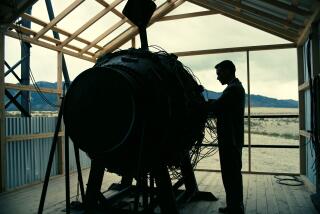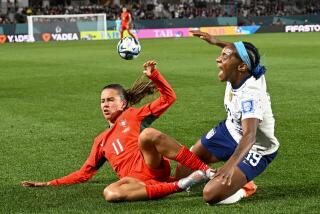Nippon’s Sun Sinks With Its Broken Boom : America’s Cup: Japanese respectable despite horrific circumstance.
- Share via
SAN DIEGO — Broken mast, broken rudders, broken boom, broken dream--the Japanese have felt the weight of the America’s Cup through the past 12 months, but it hasn’t broken their hearts or their resolve.
And even on the verge of elimination they seem less confused than the house of mirrors on Harbor Drive: America 3, the powerhouse defender which keeps changing boats and lineups and helmsmen like “musical chairs”--helmsman Buddy Melges’ own words.
When Nippon’s boom broke like a wishbone 5 1/2 minutes before the start of Sunday’s race against Il Moro di Venezia, there was only a momentary thought of giving up, even though its chances of surviving the challenger semifinals already were foundering.
Instead, Chris Dickson’s Nippon crew patched and jury rigged as they went up the first, windward leg, hanging in remarkably well against one of the teams that figures to reach the finals of the Louis Vuitton Cup, and losing by only 1 minute, 53 seconds.
That was closer than their 2:04 loss to the Italians last Tuesday, and closer than Ville de Paris’ 3:11 loss to New Zealand in Sunday’s other semifinal.
Bruno Trouble, director of the Louis Vuitton media center, said, “Either these boats don’t need a boom, or (Il Moro) didn’t push much around the course.”
Meanwhile, maintaining a front of organized direction, Bill Koch’s America 3 team shows signs of disarray behind the walls, as if Dennis Conner’s comeback in winning five of their last six races has thrown the camp into chaos.
Nobody seems to know who’s going to be steering either boat one day to the next. On Saturday, Koch explained that he left Melges behind for the race against Stars & Stripes because Melges wanted to stay on Kanza, the newer boat, all the time.
Guess who showed up Sunday sailing America 3 with new helmsman Kimo Worthington, while Koch sailed Kanza?
Worthington, who has rotated from mainsail trimmer to non-sailing boat captain to helmsman, was at the helm for most of Sunday’s 34-second victory over Kanza--America 3’s first win in this knockout round.
Melges said afterward, “We played a lot of musical chairs, and yesterday there weren’t enough for me to sit on. So today I became the esteemed tactician for Kimo Worthington.
“It was my idea to make the changes in the afterguard yesterday. Once in a while the old man (Melges is 62) needs a day off, and I would like to watch and see what I can put into the program.
“I guess the question is, ‘Is it difficult for you to make a decision?’ Sometimes it’s yes and sometimes it’s no.”
That was Zenda (Wis.) humor. Tactician Dave Dellenbaugh said, “I’ll give you the real answer to the question. Bill Koch wanted to steer one boat and get as much helm time as he could. He decided to steer 28 (Kanza) because Kimo’s gonna be steering 23 (America 3) and has a lot less helm time than either (Koch or Melges).
“In the past few days we’ve had some concerns about the speed of 23 in lighter air, so Buddy went on the boat today to try to get it up to speed because he’s our best guy (for that).”
Melges added that the decisions also are based on the anticipated sailing conditions--light wind, heavy wind, etc.
“We know where our strengths are, and we’re using those strengths to optimize our boats,” he said. “I don’t think it’s in chaos at all.”
The Japanese, with all their troubles, at least remain focused. After suffering a broken rudder shaft Wednesday and the boom Sunday, they are now 1-5 with only three semifinal races remaining, but their effort hasn’t diminished.
The boom broke in a sea confused by a heavy swell rolling perpendicular to steep waves driven by southerly winds of up to a moderate 12 knots. The shock of the boat plunging hard off a crest into a trough was too much for the $40,000, carbon-fiber spar.
“It was obvious we weren’t going to be going very fast,” Dickson said. “For one fleeting moment I considered pulling out. The answer was very quick: ‘We’ll do the best we can. We’ll keep fighting. We’re down but we’re not out yet.’ We’d give up a point, probably, but Il Moro was going to have to work for it.”
Last May, when the Japanese collapsed after breaking their mast in the International America’s Cup Class Worlds, there was a question of their resiliency. This time they drew praise from all their rivals.
New Zealand skipper Rod Davis called it “an impressive display of seamanship . . . typical of the effort they’ve put forth through this whole regatta.”
Near the end of the first leg, when the boom finally broke completely in two a few feet behind the mast, they disconnected it and let it slip off the stern for their chase boat to collect.
Then they proved that the new 75-foot IACC boats with their 110-masts can be sailed without a 25-foot boom--like Michael Andretti driving on three wheels or Evander Holyfield fighting with one hand tied behind his back. After refitting themselves under way, they were no farther behind--1:29--at the first mark than at the last.
Il Moro skipper Paul Cayard said, “I thought (Dickson) was really in a lot of trouble. I couldn’t believe he could sail the boat as well as he did. In fact, I made a mistake in being a little lenient on him. I should have got all over him and made life as difficult as I could for him. But I chose the tactic of just staying clear, assuming we were going to be much faster, but that didn’t turn out to be the case.”


